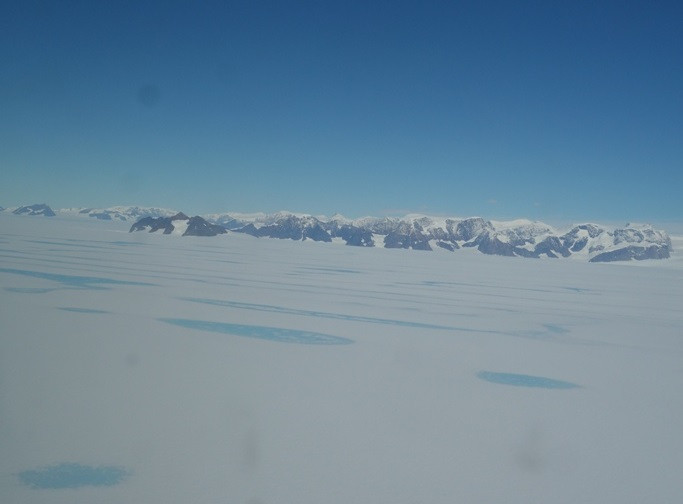Fragile Larson C ice sheet warmed by strong Antarctic mountain winds
Föhn winds are blowing across the top of the ice sheet, while warm sea water melts it from below.
Warm winds pouring down the sides of the mountain range that runs the length of the Antarctic Peninsula are melting ice sheets up to 100 kilometres away.
The winds could be behind the growing collection of pools and cracks on the Larson C ice sheet, which lies towards the tip of the peninsula and is looking particularly vulnerable. Its companions Larson A and Larson B broke off spectacularly in 1995 and 2002 respectively.
Föhn winds have now been identified as contributing as much as an extra 40 millimetres of melt across the ice sheet each year at a distance of 100km. Closer to the mountains, the figure is expected to be higher.
Antarctic sea ice melt contributes to rising sea levels, but the first study to look at the wide-ranging consequences of these mountain winds – known as föhn winds – finds that they have much further-reaching effects than previously realised. They are also causing melting throughout the year, not just in summer time as was thought before.
How do föhn winds form?
These winds happen when wind blows directly into a mountain range, forcing air upwards and cooling it at a rate of about 10C per kilometre of altitude. As it cools and clouds start to form, the rate of cooling slows to about 5C per kilometre.
As the wind falls down the slope of the mountain range on the other side, it warms at a steady rate of about 10C per kilometre. As a result, air can be about 5-10C warmer when it reaches the bottom of the slope again than when it hits the mountain range.
The dominant winds around Antarctica blow from east to west, while the mountains of the Antarctic Peninsula run in a north-south direction. This creates the ideal conditions for strong föhn winds.

Far-reaching consequences
The strongest effects of the winds are expected to be on the ice close to the mountain range, but there are few studies in these areas, study author Jenny Turton of the British Antarctic Survey and the University of Leeds told a press conference at the EGU meeting in Vienna.
"They're a lot more spatially extensive than we thought and also more frequent. Larson C is the size of Wales. So if this föhn happened in Snowdonia, you would still be able to feel the impacts at the English border," said Turton.
The winds were detected as close to the pole as latitude 68.1 degrees south, the southernmost point they have ever been detected. They are bringing ice melt onset earlier as well as leading to overall more melting of the ice.
The next steps in the research are to try to find a historic record of föhn winds near the peninsula and find a way of projecting their severity into the future, Turton said.

© Copyright IBTimes 2025. All rights reserved.






















